
Saturniidae, members of which are commonly named the saturniids, is a family of Lepidoptera with an estimated 2,300 described species. The family contains some of the largest species of moths in the world. Notable members include the emperor moths, royal moths, and giant silk moths.

Saturnia pavonia, the small emperor moth, is a moth of the family Saturniidae. It was first described by Carl Linnaeus in his 1758 10th edition of Systema Naturae. Sometimes, the incorrect genus name Pavonia is still used for this species. This moth occurs throughout the Palearctic region and is the only member of its family to be found in the British Isles, where it is usually called simply the emperor moth.

Eacles imperialis, the imperial moth, is a member of the family Saturniidae and subfamily Ceratocampinae. It is found mainly in the East of South America and North America, from the center of Argentina to south Canada. The species was first described by Dru Drury in 1773.
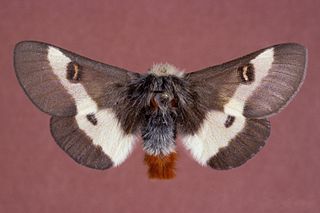
The buck moth is a common insect found in oak forests, stretching in the United States from peninsular Florida to New England, and as far west as Texas and Kansas. It was first described by Dru Drury in 1773. The larvae typically emerge in a single generation in the spring. The larvae are covered in hollow spines that are attached to a poison sac. The poison can cause symptoms ranging from stinging, itching and burning sensations to nausea. Subspecies Hemileuca maia maia is listed as endangered in the US state of Connecticut.
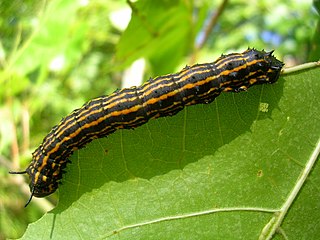
Anisota senatoria, the orangestriped oakworm, also known as the orange-tipped oakworm, is a Nearctic moth of the family Saturniidae and subfamily Ceratocampinae. It is one of the more common Saturniids, reaching pest status occasionally in the northern parts of its range. As they are late-season feeders, however, they do little lasting damage to their hosts. It is very similar to A. finlaysoni in southern Ontario and A. peigleri in the southern US. The species was first described by James Edward Smith in 1797.
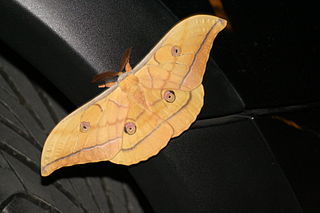
Antheraea yamamai, the Japanese silk moth or Japanese oak silkmoth is a moth of the family Saturniidae. It is endemic to east Asia, but has been imported to Europe for tussar silk production and is now found in southeastern Europe, mainly in Austria, northeastern Italy, and the Balkans. It seems to be spreading north and a population has been reported near Deggendorf and Passau in Germany. The species was first described by Félix Édouard Guérin-Méneville in 1861. It has been hybridized artificially with Antheraea polyphemus of North America.
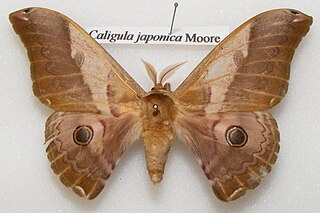
Caligula japonica, the Japanese giant silkworm, is a moth of the family Saturniidae. It was described by Frederic Moore in 1872. It is found in eastern Asia, including China, Korea, Japan and Russia.

Eacles oslari, or Oslar's eacles, is a moth of the family Saturniidae. It is found from the Santa Rita, Patagonia, Atascosa and Huachuca mountains of southern Arizona south into Sonora, Sinaloa and Chihuahua in Mexico. Wings vary from yellow to purple brown. The species was first described by Walter Rothschild in 1907.
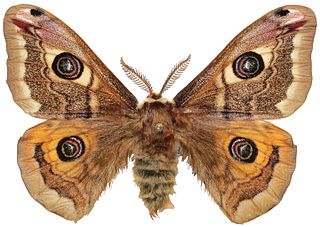
Saturnia pavoniella is a moth of the family Saturniidae. It is found in the alpine regions of Austria, Italy and the Czech Republic across south-eastern Europe to northern Turkey and the Caucasus. It is possibly also present in south-eastern France.

Automeris metzli is a moth of the family Saturniidae. It is found from Mexico to Venezuela, Colombia and Ecuador and can also be found in Trinidad

Automeris zozine is a moth of the family Saturniidae. It is found in Mexico, south to Guatemala and Colombia.

Perisomena caecigena, the autumn emperor moth, is a moth of the family Saturniidae, first described by Franz Josef Kupido in 1825. It lives in Italy and then from south-eastern Austria through Hungary, Slovenia, Croatia, Serbia, Albania, the western Ukraine, Romania, Bulgaria and Greece to most of Turkey and the Caucasus Mountains of the Republic of Georgia, Armenia and Azerbaijan. There is also an isolated population in the mountains of Lebanon and Israel. Subspecies stroehlei is endemic to the Troodos Mountains of Cyprus.

Anisota virginiensis, the pink-striped oakworm moth, is a species of silk moth of the family Saturniidae.

Anisota peigleri, the yellowstriped oakworm, is a moth of the family Saturniidae. The species was first described by Jules C. E. Riotte in 1975. It is found in the United States from south-eastern Kentucky, south-western Virginia, eastern Tennessee and western North Carolina south through western South Carolina and central Georgia into north-central Florida.

Gynanisa maja, the speckled emperor or chipumi, is a moth of the family Saturniidae. The species was first described by Johann Christoph Friedrich Klug in 1836. It is known from South Africa to eastern Africa. Gynanisa nigra is just a darker form and not a distinct species.

Anisota oslari, or Oslar's oakworm moth, is a moth of the family Saturniidae. It is found from south-western Colorado south through New Mexico and south-eastern Arizona to far western Texas and Mexico.

Citheronia laocoon is a species of moth in the family Saturniidae. It is found from the Guianas south to northern Argentina.

Coloradia prchali or Prchal's pinemoth, is a species of hemileucine silkmoth (Saturniidae) from eastern Sonora and western Chihuahua in the Sierra Madre Occidental pine–oak forests. Its habitat includes conifer-oak forest composed of Pinus ponderosa, Pinus engelmannii, Pinus leiophylla, Juniperus deppeana, Quercus arizonica, Quercus grisea and Quercus viminea.
Rhodinia verecunda is an endemic moth species belonging to the genus Rhodinia of the family Saturniidae. It is endemic to Taiwan.


















